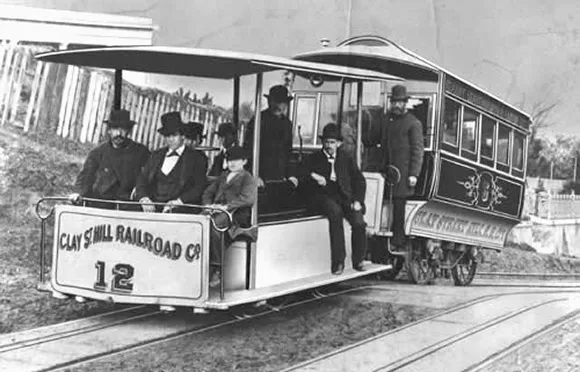1873: The Birth of an Icon
Picture San Francisco in 1873. The air vibrates with a restless energy, a city still riding the wave of the Gold Rush. Buildings climb ever upwards, clinging to the sides of the city’s defining feature: its iconic hills. Yet, traversing these slopes posed a formidable challenge. Horse-drawn carriages, the primary mode of transportation, struggled, often in vain, against the city’s relentless inclines. It was a time ripe for innovation, and Andrew Smith Hallidie, a Scottish engineer, answered the call.
Witnessing the dangers and inefficiencies of horse-drawn carriages firsthand, Hallidie was spurred to action. Legend has it that he watched in horror as a team of horses, strained beyond their limits, faltered on a steep incline, sending their carriage tumbling back down the hill in a disastrous heap. Determined to find a safer alternative, he drew inspiration from an unlikely source: the mines.
Hallidie, well-versed in the mechanics of wire rope technology used in mining, envisioned a system where cables, hidden beneath the city streets, would pull the cars along, powered by a central steam engine. “[Hallidie] improvised machinery, sent to San Francisco for wire, and made a wire rope one-eighth of an inch thick and twelve hundred feet long, consisting of three pieces spliced together, which did its work for two years,” recounts an anonymous source, possibly from a biography of Hallidie.
A City Transformed: The Impact of the Cable Car
And so, on August 1, 1873, after years of planning and experimentation, the first cable car made its maiden voyage up Clay Street. This wasn’t just a technological marvel; it was a paradigm shift for San Francisco.
The cable car system, with its underground cables, gripping mechanism, and braking system, was ingenious in its simplicity and effectiveness. San Francisco’s challenging terrain was no longer an obstacle but a testament to human ingenuity.
The impact was immediate and profound. Neighborhoods, once isolated by the city’s topography, were now easily accessible. Businesses flourished as people could effortlessly navigate the city. San Francisco’s cable cars weren’t just transporting people; they were transporting the city itself into a new era of progress and prosperity.
Beyond the Hills: The Cable Car’s Legacy
The cable car’s influence extended far beyond San Francisco. Cities around the world, grappling with similar topographical challenges, looked to San Francisco as a model for urban transportation. The cable car was more than just a mode of transport; it represented a city’s determination to overcome adversity through innovation.
Despite facing competition from electric streetcars and enduring setbacks such as the devastating 1906 San Francisco earthquake, the cable car persevered. Its resilience mirrored the city it served. In 1964, the cable car system was designated a National Historic Landmark, solidifying its place as a national treasure.
1873: A Year of Innovation
Interestingly, 1873 wasn’t just the year of the cable car’s birth. It also marked another iconic invention: the riveted blue jean. While Hallidie was revolutionizing transportation, Levi Strauss and Jacob Davis were busy changing the world of workwear with their patented denim trousers. Like the cable car, blue jeans, initially designed for durability, would go on to transcend their utilitarian origins and become a global symbol of American culture.
Riding the Rails of History: The Cable Car Today
While many cities have phased out their cable car systems, San Francisco’s has endured, evolving from a transportation necessity to a beloved cultural icon. Today, three cable car lines still wind their way up and down those legendary hills, offering residents and tourists alike a tangible link to the city’s rich past.
Stepping onto a San Francisco cable car today is like stepping back in time. The clang of the bell, the whir of the cable beneath your feet, the wind whipping through your hair as you climb those iconic hills – it’s an experience that captures the very essence of San Francisco: a city that embraces its history while constantly striving for innovation.
For those seeking a taste of old-world charm, a ride on a San Francisco cable car is a must. It’s a journey that transcends mere transportation, offering a glimpse into the heart and soul of this captivating city.
Want to learn more about San Francisco’s fascinating history and culture?
Check out these other articles:
- 1920s outfits for guys who want to channel the era of gangsters and flappers.
- Did you know that the Ottoman battle of Vienna led to the invention of the bagel?
- Discover the sinking of the Rainbow Warrior, a pivotal event in the fight for environmental protection.
- Bronze Age collapse memes offer a humorous take on the mysterious downfall of ancient civilizations.
- Discover Trasa Robertson Cobern’s Mentors: Shaping Her Hurst Campaign - July 9, 2025
- Discover People Influenced by Trasa Cobern: A Legacy of Service - July 9, 2025
- Discover Trasa Cobern’s Nonprofit Impact: A Deep Dive - July 7, 2025
















